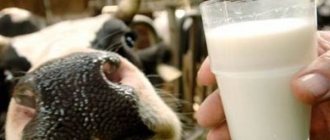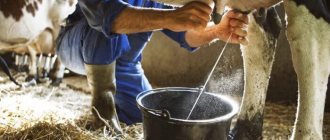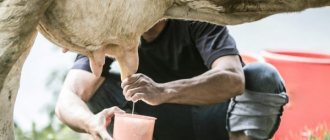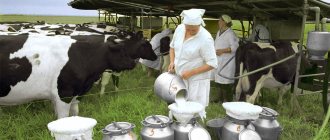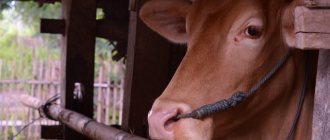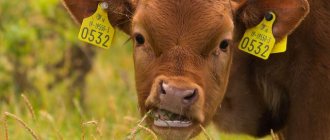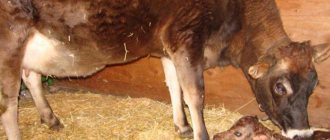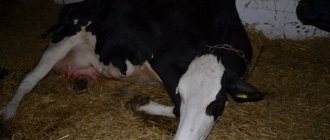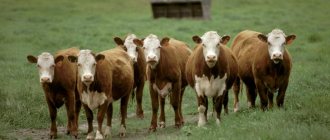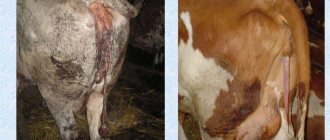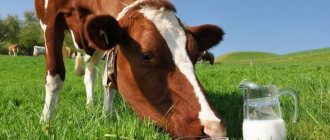Doctors recommend drinking milk daily for both children and adults. In the village, the problem with a healthy product is solved traditionally - by getting a cow. If the cow turns out to be highly productive, then it will be possible to feed the family, and there will be milk left for sale. People prefer to buy young dairy cows, but if there is no good option, then they have to buy heifers. The owner will receive milk from her only after the birth of the offspring. But the first heifer still needs to be milked properly, so the owner should listen to the recommendations of livestock specialists.
What affects milk production?
A cow's performance depends on both genetics and care. In the old days they said that cows had milk on their tongue. This means that if a cow is not fed, then high milk yields should not be expected from her. First heifers produce less milk than older animals, but over the years their productivity will increase. The nurse's milk yield reaches its maximum by the fifth or sixth lactation; for several years it will remain at approximately the same level, and then begin to decline.
The main factors that influence the performance of first-calf heifers:
- proper feeding;
- breed of cow;
- proper preparation for calving;
- health status.
If an animal is kept on poor quality water and hay after giving birth, then there will not be high milk yields. Or in the first couple of weeks the first heifer will give the owner 12-17 liters, but then it will greatly reduce. It will not be possible to restore milk yield during this lactation. Productivity depends greatly on the breed of the cow and its ancestors. How to milk a first heifer and get a lot of milk from her? A farmer should buy a Holstein cow. They are demanding to keep, but with good care they produce a lot of milk.
How much milk does a cow give after calving?
The amount of milk produced by a cow depends on a number of factors - breed, age, housing conditions and feeding. If you follow all the rules, you can get 5-6 thousand liters of nutrient fluid per year from one animal - about 15 liters per day. A primiparous heifer produces about 7-12 liters, and the amount increases with age.
Cows that produce at least 20-25 liters of milk per day are considered record holders, but sometimes higher figures are found - from 60 to 100 liters per day. The milk production of the most common cattle breeds is as follows:
- Simmental cows – 5-9 thousand liters per year;
- Holstein breed - 6.5-7 thousand liters per year;
- black-and-white cows – 5.5-6 liters per year;
- Yaroslavl breed - 6.5-8 thousand per year.
To determine a cow's milk production, a special analysis can be done. Blood is taken from the animal, after which its viscosity is determined. Representatives of cattle with viscous blood are considered highly productive, and those with a lower indicator are considered low-productive.
Cows live 10-15 years, that is, during this time they can produce offspring about 10 times. The reproductive age of cattle ends at 15 years of age - they stop becoming pregnant, and therefore stop milking. After the first calving, the amount of milk increases over five years, reaches a maximum in six-year-old heifers, after which it begins to gradually decrease.
The reasons for decreased milk production vary, but most often the root of the problem lies in improper care and poor nutrition. This is especially true in winter, when the diet becomes less varied and there is no opportunity for walking. In addition to a varied and nutritious diet, it is important to provide the animals with the right living conditions - clean bedding, a draft-free room, and sufficient water. To increase milk yield, cows should be regularly examined, especially the udder - cracks, mastitis and other diseases reduce the amount of milk.
Before milking, the udder must be washed with warm water, after which it is lubricated with special ointments and a light massage is given. Compliance with the milking regime is also important. When the mammary glands are full, milk production stops, and if this situation repeats, milk yield is significantly reduced. If the cow consistently produces a small amount of milk (less than 5-7 liters per day), it is better to contact a veterinarian - the reason may lie in diseases that only a specialist can determine.
The milk production of cows largely depends on the breed and characteristics of the animal’s body, but with proper care and feeding, the amount of milk increases to the maximum. Remember that healthy, well-groomed cows that receive the necessary nutrients have virtually no problems with milk production.
Is it possible to let a calf in?
In villages, the method of keeping young animals under a cow is common. After birth, the calf is left with its mother, and the owner milks the cow a little several times a day. This method has a right to exist, but it is more suitable for meat breeds of animals. In a dairy cow, the calf will spoil the udder. In addition, she will begin to squeeze milk for her child, so the owner may not get anything.
It is especially harmful to keep a baby under a first-calf heifer. It will be difficult to accustom such cows to milking. A cow can kick, kick her owners, and overturn a milk bucket. Then people will try to get rid of the obstinate cattle or hand them over to a meat processing plant. How to milk a first heifer correctly? The baby that is born must be taken away immediately; soon the cow will forget about him. Afterwards, the owners must empty the first-calf's udder themselves, following the basic rules of milking.
Heifer nutrition
A cow's milk production depends on the balance of her diet. If the first heifer is kept on hay and water after giving birth, then it is pointless to expect high milk yields from her. After the baby is born, the cow should eat a lot of high-quality bulky food. The basis of her diet for this period is good hay. But the first heifer should also receive grain.
Immediately after giving birth, the cow develops udder swelling. It is in the owner's interests to get rid of it as quickly as possible. Therefore, until the swelling disappears, you cannot increase the grain rate; this will only intensify it. After the first heifer's udder returns to normal, either salt or mineral lick is introduced into her diet. The grain supply rate begins to increase from 2-3 weeks after birth. All changes in the cow's diet should be gradual.
What can interfere with the milk supply?
The owners want to get a large amount of milk, but their mistakes can prevent an increase in productivity. If a cow was not properly prepared for calving, she will not demonstrate high milk yield. The heifer must be in normal condition before giving birth. She should make a good external impression: not fat, but not thin either. There is no need to overfeed a heifer with grain, but putting him on water and hay before giving birth is also unacceptable. If a cow did not receive enough nutrients during the dry period, then she will not give much.
How to milk a first heifer? You need to feed her a balanced diet and let her go for walks every day. The cow can be taken into the herd or released into the yard. If the owners have time, they can graze the first heifer themselves. Walking has a beneficial effect on the cow's milk yield.
Care and high milk yield
The cattle owner must provide the cow with proper care and then count the liters of milk per day. You need to take care of a pregnant woman even before giving birth. To do this, you need to gradually prepare the udder for future milkings.
The time after calving is the most important time for the farmer. How much milk a cow produces throughout her lactation period depends on his competent actions. After all, the first three months are the most productive for milk. The cow gives up almost half of its total volume for the year. Then the numbers gradually drop.
It is believed that to be productive, a cow should become pregnant within the next one to two months.
If successful mating does not occur, then the cow becomes barren and will reduce milk yield every day. Soon the milk will disappear altogether.
But if a cow’s milk supply suddenly decreases, you should pay attention to her health. This is necessary if the levels drop below ten liters per day. Many diseases, including inflammation of the udder, lead to a drop in daily milk yield and the disappearance of milk.
Some of them can be identified by external signs:
- with mastitis, the animal’s udder heats up, turns red in places, and clots appear in the milk;
- with foot and mouth disease, ulcers can form on the nipples, from which pus flows into the bucket with the product;
- with cracks in the nipples, milk yield decreases rapidly due to severe pain;
- When the udder swells, it becomes larger, but there is no milk in the tanks.
In most cases, timely treatment helps restore the animal's productivity. In any case, decent daily milk yield is shown by a well-fed, healthy and recently calved cow, which is properly handled by the skilful hands of the milker.
Smart Technology Smart Agriculture Cow Goat Milking Chicken Collection Eggs Pig Calf Fee
Title Smart technology Smart agriculture cow Goat milking chicken collection Eggs pig calf payment Viewing time 17:46 Title How much money will one cow bring Viewing time 10:47 Title THREE BUCKETS OF MILK OR HOW MUCH DO OUR COWS GIVE MILK PER DAY?! Viewing time 6:25 Author rating Author of the article Igor Nikolaev Articles written 787
Expansion of the herd through the calving of an adult cow is a desirable event for any cattle breeder. But many of them make a big mistake, paying all their attention to the newborn offspring and thereby forgetting about proper care for the calving animal. But the cow’s productivity for the entire next lactation season directly depends on its quality and proper milk yield. Knowing how to properly milk a first-calf heifer, farmers not only increase the milk productivity of their farm, but also contribute to the health of the animal.
Milk yield of first-calf heifers
Udder care before milking
Cleanliness starts in the area where the cows are kept. The cow's bedding should always be dry and fresh. Only from a clean udder can you get milk that meets all hygiene standards.
Preparing a cow for milking begins with cleaning. You can do it in 3 ways:
- dry;
- wet;
- wet.
After cleansing, the udder is dried. For the dry method, napkins are used. They must be individual for each cow. If the napkins are reusable, they should be disinfected between milkings. The dry method cleans the udder well, but not perfectly.
For the wet method, paper napkins are moistened in a special solution. If it contains alcohol, the udder dries out faster. The wet cleaning method is recommended for heavily soiled areas.
Massage
After calving, the udder is swollen, making it more difficult to milk. Therefore, massage is necessary for a cow. It enhances milk production, helps develop a conditioned reflex, and improves the heifer’s adaptation to milking.
There are several technologies for udder massage:
- stroking;
- trituration;
- kneading.
The farmer's hands should not be cold, as this may frighten the heifer. The massage should begin with gentle stroking. Then you can gently push the mammary glands, imitating the behavior of a calf. Just don't act rudely, this will lead to problems. During the massage, the hormone oxytocin is produced, which improves milk flow. After the procedure, the blood should be milked immediately.
Choosing a cow for milk production
A balanced and responsible choice of cow milk is no less important, since the amount of dairy product will depend on it. How not to make a mistake in choosing and why is it necessary to pay attention to certain points? Let's highlight the main points of the right choice:
- legs. The cow must have strong limbs, it is advisable to check the gait of the cow; an even and confident step is an indicator of a good cow;
- udder. A large udder can ensure good milk production, the presence of visible large veins is excellent;
- belly. A saggy belly is an indicator of careless, sloppy, improper care of the animal;
- breast. Definitely deep and wide. A significant sagging of the breasts by 15-25 cm is a good reason to refuse the purchase;
- tail. Its base must be thin. If the base of the tail is wide, then this is an indicator of poor physique of the cow;
- head. The skull of a milk cow is elongated all the time, and thin and small horns are also a big plus;
- ribs The intercostal distance indicates the state of the respiratory system. A small arrangement of the ribs among themselves indicates underdeveloped lungs.
Read more: Diseases of cattle cattle abscess lichen traumatic pericarditis acidosis symptoms and treatment
When choosing, you need to pay attention to the age of the animal; a very old cow is unlikely to please you with significant milk yield. Milk production decreases significantly after 10-12 calvings.
- udder. A large udder ensures high milk productivity, the presence of large visible veins is excellent;
- legs. A cow should have strong limbs; it’s a good idea to check the animal’s gait; a confident and even step is an indicator of a good cow;
- breast. Be sure to be wide and deep. Severe sagging of the breasts by 10-20 cm is a serious reason for refusing to purchase;
- belly. A saggy belly is an indicator of improper, sloppy, careless care for the animal;
- ribs The intercostal distance shows the state of the respiratory system. The close location of the ribs to each other indicates poorly developed lungs;
- head. The skull of a good cow is always elongated, and another big plus is small and thin horns;
- tail. The base of the tail should be thin. The wide base of the tail is an indicator of the cow’s poor physique.
When choosing, pay attention to the age of the cow; a cow that is too old is unlikely to please you with large volumes. Milk production decreases significantly after 9-10 calvings.
Razdoy
After giving birth, the cow produces colostrum for several days. It is oilier and often has a yellowish color. After this, the cow begins to produce transitional milk. It is not so tasty, it is usually not sold, but rather drunk with the family. Then the cow begins to produce mature milk.
The first milking should be done within an hour after birth. This is done in order to quickly feed the calf with colostrum. In the first weeks there is no need to try to get record milk yield. The milk at this time is not entirely complete, and the cow has not yet fully recovered from giving birth. If you immediately force a cow to eat a large amount of feed, it may get sick.
There are different opinions regarding the frequency of milking. Some schemes are used on farms, while others are used on private farms. Livestock specialists working with highly productive Holstein cows recommend milking them 2 times a day. In villages, this procedure is carried out 5-6 times a day in the first week. How to milk a first heifer? The owner can adhere to any of these schemes, they have both been tested on many cows.
How soon does a cow start giving milk?
Cattle differ from other farm animals in that they grow rather slowly and reach maturity late.
The heifer becomes sexually mature only after 6 months, but high-quality offspring can be obtained much later. At the age of 1.5 years, when the live weight of the cow averages 300 kg, it can be mated with an inseminating bull. And dairy products can only be obtained after calving. Primary milk, colostrum, is not consumed by humans, since it is extremely necessary for a newborn calf. The process of bearing a calf lasts 9 months, but the cow does not produce milk 365 days a year. Milk yield begins to decline, reaching 0.5 liters per day, so the cow is taken to the bull every year.
Before calving, the animal stops milking. This process is called starting a cow. It is necessary to prevent exhaustion of the body of the expectant mother and calf. How many liters of milk a cow will give after the first calving and what its fat content will be depends on many factors.
Cow's milk was originally intended only for feeding the calf, since the cow belongs to the group of mammals that feed their offspring with milk. But modern man, immediately after birth, tries to separate the baby and mother and give milk to the calf in portions at his own discretion, taking the main part for his personal needs. The cow's body perceives milking as a natural process of feeding the baby.
When does a cow start giving milk? At the age of 6 months, a young cow has already reached sexual maturity and is capable of insemination, but the cow does not yet have the ability to normally bear a baby and give birth to healthy offspring; accordingly, fertilization is delayed until about 2 years. By this age, the first heifer will be fully formed and gain the necessary weight to bear a baby.
It is necessary not to forget that all year round the animal will provide milk only with the condition of constant milking, thus the animal’s body will constantly feel the need to reproduce milk. Regular milking is the key to good milk yield. Milking is completed 2 months before calving.
For any cow, milk begins to come immediately after calving; for the first 2 weeks it has a specific smell and taste, is characterized by a special composition and high fat content. It is called colostrum, it is used only for a newborn baby. Let's try to figure out what the average milk yield of a cow is per day.
These sedate animals grow and mature rather slowly. The owner takes care of the new heifer for a long time, counting on the return only in the future. Cows reach puberty after six months, but such a young animal is not ready to reproduce. Only at one and a half to two years, when the heifer has fully developed and reaches a weight of more than 300 kg, is she fertilized.
A cow's pregnancy lasts 9 months, approximately 240 to 311 days. After the calf is born, milk appears. At first, the cow produces colostrum, which the calf feeds on; it is not eaten. Thus, the owner of a cow will be able to receive the first milk only after two and a half to three years.
The female begins to produce milk at the end of pregnancy or after the calf is born.
A young heifer is not ready to please the owner with milk production until her first pregnancy. This period begins at one and a half or two years. The female begins to produce milk at the end of pregnancy or after the calf is born.
At first, the milk is intended for the baby. It is fatty and thick, called colostrum.
How to accustom a first-calf to milking?
A young cow may be afraid of the milk production procedure, so the owner should be especially attentive to her. How to milk a cow after her first calving? 2-3 months before giving birth, the owner can accustom the animal to stroking the belly and udder. In this case, the cow most often takes milking calmly.
If the first heifer kicks, the owner may tangle her hind legs. There is another way to pacify an obstinate animal, which is often used in villages. The front leg is tied up and raised up. The heifer, balancing on 3 limbs, will not be able to kick, and the owner will calmly milk her. Sometimes it is enough to threaten a cow with a twig, and after that she will stand still.
The process of milking a cow
Immediately after calving
Calving is the process during which the gestation and birth of a calf occurs. At this time, the heifer spends a lot of energy on giving birth to young animals, but she cannot stop milking.
How to milk a cow after calving? After the female has given birth, you must wait 15 days. This is necessary because at this time she secretes substances that go to feed the calf. After this period, milk can be consumed for human consumption.
Don't try to get maximum volume. This will lead to overstrain of the mammary gland, and all sorts of diseases may occur. To milk a heifer after giving birth you must:
- give salt water to the cow half an hour after giving birth, this will remove thirst and help restore strength;
- After 2-3 hours you can start milking, but you must not overdo it - milking all the milk is prohibited, otherwise this will lead to illness in the animal. This milk must be given to the calf.
Milking must be done 3 to 5 times a day to avoid stagnation. After each milking, massage should be done.
Cow udder massage
After a false pregnancy
There are cases when cows experience a false pregnancy. It is very difficult to distinguish it from the usual one, only with a special examination by a veterinarian. During a false pregnancy, the belly also swells, but subsequently fluid comes out instead of the calf. There is nothing wrong with this, just a normal biological process.
After all the liquid has come out, you need to carefully start dispensing. It is advisable to wait a few hours. It needs to be started carefully, gradually milking out the milk product, but not all of it.
How do the nutritional value of the diet change when cows are milked?
Food is the main source of energy for any organism. Therefore, it is worth paying attention to your diet.
It's no secret that food directly affects the quantity and quality of milk. If you want to increase your milk yield, you need to include in your diet:
- roots;
- special feed;
- increase the amount of grass and hay.
It is necessary to introduce fruits and vegetables into the diet to maintain vitamins and other beneficial elements. Without them, the amount of dairy product will not increase. Don’t forget about special additives that increase milk yield.
Proper nutrition improves milk yield
You also need to take into account the desired volume of milk, and from this choose a suitable diet, and in addition to everything, take into account the characteristics of your cow:
- average. With such a cow, you can count on increasing the amount of milk by 3-4 liters;
- highly productive. If you have such a cow, then you can increase your milk yield by 4-6 liters;
- unproductive. It is very difficult to increase the volume of milk produced with the help of a certain diet; it is better to use special supplements.
Attention! Under no circumstances should you feed a cow the same type of food, this will only reduce the amount of milk.
If the animal has not increased its milk yield, then an experiment should be conducted: give certain products for about a week and observe what causes the amount of product to increase. The diet needs to be changed every 2-3 weeks. You cannot overfeed the animal, this leads to loss of appetite and even milk. Instead of eating a lot of food, you need to water the cow well.
Milking
There are times when a small amount of milk is milked due to improper milking technique. Therefore, you must follow all the milking rules:
- Schedule. The heifer needs to know when milking will begin. This will help her produce as much milk as possible at this time.
- Feeding. The animal must be fed two hours before milking with food that increases milk yield.
- Before the process, you need to wash and wipe the udder. The first small amount of milk should not be poured into a common container - they contain germs and pathogenic bacteria. When draining, you need to pay attention to the liquid: there should be no blood clots or mucus in it, because this is a sure sign of an animal’s illness.
During the process, you need to milk the back and then the front udder, but not with your fingers, but with your whole fist. If you milk incorrectly, you can injure the udder or introduce dirt; you should not allow milk to flow through your fingers. The entire milking should be done in no more than 5 minutes. If there is still milk left, then you cannot touch it. Subsequently, you can learn to milk most of the milk during this time. But this will take some time. Proper milking increases the amount of milk product. Milking a cow after calving must be done in the same way, only with even greater care.
Manual milking method
Not every family in the village has the opportunity to buy a device. If there are few cows, then the farm most often practices manual milking. This method is the most accessible and does not require the purchase of additional devices. Manual milking is done using two methods – fist and pinch. Before the procedure, the udder is cleaned and massaged.
If the cow's teats are of normal size, then it is most convenient to milk her with your fist. Before the procedure, your hands should be lubricated with cream, Vaseline or fat for better glide. With this method, the nipple is grasped with the fingers, after which the fist is alternately compressed and unclenched. This must be done until the milk is completely gone.
Goats are most often milked by pinching. In cows, this method is used only if the nipples are very small and cannot be grasped with your fist. This method uses only two fingers. How to accustom a first-calf to milking by hand if she has small nipples? You need to use the pinch method. The mistress clasps the nipple with her thumb and forefinger, and then moves them down. At this moment, milk is released from the gland and enters the milk pan.
Feeding for milking
When calculating feeding rates for a cow, it is necessary to take as a basis not the actual milk yield, but the one that needs to be obtained:
- Medium cows. The diet is structured in such a way as to obtain 2-3 liters of milk more than actual milk.
- High yielding. The diet is such that you get 3-5 liters more.
- Unproductive. The amount of milk is invariably small and does not depend on complementary feeding.
That is, if on days 8-12 a cow gives 12 liters of milk, then you need to expect to receive 14-15 liters from her. If the milk yield is 20 liters, then the calculation is 23-25. To increase milk yield, 1.5-2 feed units are added to the daily ration. The diet needs to be increased until milk production increases. If the amount of milk stops growing, then advanced feeding can be stopped.
Juicy feed increases milk yield.
Root crops and concentrated feeds provide the greatest increase in milk yield. If a cow increases milk yield in response to increased feeding, then you need to start adding succulent feed. But you should not reduce the amount of hay.
You can’t give homogeneous food: the animal’s appetite decreases. Therefore, if a cow does not increase her milk yield after 10-12 days, then there is no need to immediately reduce the amount of feed. It is necessary to diversify the diet: appetite increases and milk yield increases.
If, on the contrary, when changing the diet, the amount of milk decreased, you need to return to the previous diet. The feeding diet can be changed every 2 weeks. You should not take even short breaks in feeding: milk yield may decrease.
Machine milking method
With the help of automated equipment, the farmer gets cleaner milk. The milking machine reduces the processing time of the cow and makes life easier for farm workers. The heifer may be frightened by noise, so she needs to be accustomed to it in advance. A few months before the birth, you can bring the milking machine into the barn and turn it on from time to time. The first heifers will quickly get used to the noise and will not pay attention to it.
Technology of milking cows using a machine:
- clean the udder of the first-calf from dirt;
- wipe it dry;
- massage the udder;
- milk the first streams of milk into a separate bowl;
- turn on the device;
- put milking cups on the nipples;
- completely empty the udder;
- take the milk and rinse the machine.
After this, the nipples are treated with a special liquid that has a wound-healing effect. Once a week or more often, the device is washed with alkali or acid.
Udder care after milking
It is advisable to complete the milk production process with a massage. They start doing it 1-2 minutes before the end of milking. After the procedure is completed, all shares are checked. If there are seals on the udder, this means that the milk was not completely given. Then it is advisable to milk the cow by hand again.
After this, the udder is processed. The glands are washed with water, and the nipples are dipped into cups with a special solution. This is done to prevent infection from entering the udder. The solution will create a protective film that will block the entry of bacteria into the nipples. At home, you can use ordinary iodine. It will heal the nipples and disinfect their surface. If a farmer has the opportunity to buy professional products, then he can purchase Gralan.
Possible problems
After childbirth, things don't always go perfectly. Sometimes the first heifer has problems related to milk production. If they occur, then farm workers should massage more carefully. If hard areas are felt in the tissues of the udder, and the animal’s temperature is elevated, then the owner should urgently invite a veterinarian.
First-calf heifers that cannot be accustomed to the milking procedure are always culled on farms. In villages, they usually try to adapt obstinate animals to this procedure, but this is not always possible. If the first heifer cannot be accustomed to milking within several months, then she can either be sent to a meat processing plant, or several calves can be kept under her.
How to milk a first-calf cow
Proper feeding is one of the main components of first-calf milking, both in domestic and industrial conditions. In this case, so-called advance feeding is used. Its essence lies in the fact that in addition to the usual norm, the feed is regularly supplemented with several components that can increase the milk productivity of the first heifer. Most often, concentrated feed and beets are used for these purposes.
Important! Regular supplements of protein feed in the form of bean hay and special concentrates are also necessary. In addition, regular supplementation of vitamins and minerals is important.
In this case, the total volume of additives for the period of milking first-calf heifers can reach:
- for high-yielding cows (productivity from 25 liters per day) - more than 50%;
- for all others – at least 40%.
It makes sense to switch to a new type of feeding no earlier than 10 days after the calf is born. After all, immediately after calving, the entire body of the first-calf as a whole is slightly weakened, as well as the functioning of the gastrointestinal tract. You cannot immediately put such a load on it, and the mammary glands must normalize their work, otherwise there is a risk of developing mastitis.
From about day 10, you can begin to introduce a new feeding system, adding 1.5-2 additional feed units to the standard diet every week.
Attention! For every liter of milk obtained from a first-calf heifer, she should be given 300 g of concentrated supplements.
But the essence of the advance feeding system is that you always need to feed a little more additives.
For example, if a first heifer gives 20 liters of milk daily, then you should add as much concentrated feed to her as if she was already giving 25 liters. After 4-7 days of such feeding, the milk productivity of the first heifer actually goes up and reaches the calculated norm. In this case, it is necessary to increase the amount of added concentrates again. They continue to do this until the milk productivity of the first heifer stops growing. After this, they maintain the feed level at the same level for another 10 days, and then gradually begin to reduce it to standard.
As a result of this feeding system, the initial milk yield of a first-calf heifer can be increased by 28-30%.
It is equally important to adhere to a certain regime in caring for the first heifer. Food must be given to first-calf heifers at strictly defined intervals. Also, milking should occur strictly according to the clock. The cows' body quickly gets used to a certain schedule and begins to produce the maximum amount of milk by the time milking occurs. It is very important to give first-calf heifers an unlimited amount of water, changing it to fresh water at least 3 times a day.
During the warm season, it is equally important to send cows to pasture every day. Since walks in the fresh air also contribute to maximum milk production.
How to milk a heifer correctly
Milking itself and the accompanying massage are the most important elements in the milking of first-calf heifers.
For most animals, it is very important to accustom them to this procedure from a very early age. Already from the age of several months, it is advisable to regularly feel and lightly massage the udder, at the same time washing it from possible contamination. If the heifer has not been on the farm since birth, then it is worth starting to accustom her to the milking procedure immediately after meeting her. This will allow you to establish closer contact with the animal and gain its trust even before the first calving. Although rare, there are some individuals that have an overly violent and excitable character and do not allow them to approach their udder until calving. Below we will describe several ways to cope with such a situation.
Milking a first-calf at home is not always easy, and in this case it is difficult to overestimate the importance of udder massage. Massage can stimulate blood circulation in the mammary glands and increase milk production due to the work of special hormones. It can also improve the quality and fat content of milk. Massage before and after milking is especially useful and necessary for first-calf heifers, since they are often slow-milking.
Before milking, a preliminary massage is carried out, grasping each of the 4 lobes with both hands. Then:
- stroke and massage the udder tissue from top to bottom and in the opposite direction;
- slightly lift it on the palms, imitating the movements of a calf, and shake it slightly;
- massage the first-calf's nipples themselves, but without expressing anything.
After the main part of the milking has been carried out, a final massage is carried out, which consists of almost the same movements. But in addition, the first heifer’s udder is also kneaded entirely from the sides to the center and from top to bottom, feeling and removing all possible compactions. After which you can carry out additional milking and collect some additional amount of milk.
Comment! It is the last doses of milk that are milked that have a high fat content, so it is very important to collect them completely.
Finally, wipe the heifer’s udder with a damp cloth, then dry it with a towel and lubricate the nipples with Vaseline or a special cream after milking.
Milking can be done in two ways:
- manual;
- using a milking machine.
Before milking, the udder must be wiped or even washed with warm water and a cloth if dirty. Then they carry out a massage and only after that they start milking.
Manual milking of the first heifer must be done using the so-called fist. That is, the nipple is taken completely into the hand, the thumb and forefinger squeeze its base, and then, by squeezing all the other fingers, a stream of milk is squeezed out of the nipple. At first, the movements must be careful and smooth, then the milking speed must be increased so that the milk output also increases.
Fold two lobes first, then the next two, or alternating them. The milk should be milked completely; this is very important to do especially for the first heifer. Since it is complete milking that stimulates the process of milk formation and prevents many udder diseases.
Milking machines are usually used on farms where it is difficult to milk a large number of cows by hand. But it is recommended that first-calf heifers be milked by hand in the first weeks after birth and only gradually accustom them to milking with a machine.
In any case, massage procedures before and after milking remain mandatory for first-calf heifers, even if automated milking is used.
How to milk a heifer if she is struggling
Many first-time heifers are very afraid and do not approve of the milking procedure itself the first time. The most impulsive of them may begin to beat their legs or tail.
Of course, milking a mad first-calf correctly is not so easy even for an experienced owner or housewife. But a combination of affectionate treatment with some special techniques will help overcome this problem.
One technique that often helps to subdue an obstinate animal is to lift one front leg and tie it to a post. Standing on only three limbs, the first heifer will not be able to kick and will gradually get used to its new role.
Another technique is that before milking, a piece of heavy cloth soaked in warm water is placed on the heifer’s back or withers. This helps the animal relax, and she will be more comfortable with the milking procedure.
How to accustom a first-calf to milking using traditional methods
Since ancient times, people have also developed many ways to deal with a harmful first-calf if she does not want to accept the milking procedure and stand quietly.
Those who want to cope with the help of love, affection and a good attitude can first try tying the first heifer by the horns in the stall. But not very briefly, but so that she simply could not leave the stall. Then they place a container with delicious food in front of her, and begin to gradually milk one teat into the mug. After filling, the contents of the mug are immediately poured into a nearby bucket. After a couple of times of similar milking, you can try milking on both nipples. Soon the first heifer will get used to it and there will be no more problems with it.
There is another effective way - to collect folds of skin on the back and keep them in this form during milking.
Finally, an interesting way to handle a first-calf during milking without violence is to have another human assistant comb her with a comb throughout the entire milking procedure. After a week, the cow gets used to it and stands without any problems.
Livestock advice
If the owner wants to get a large amount of milk from a cow, then he must feed her in a balanced manner. Grain must be included in the cow's diet, but one must be wary of excess concentrated feed. If, for example, there is an excess of barley or corn, then sooner or later this will lead to disturbances in the animal’s body.
You should not cover the first heifer in the first heat after giving birth, she will not have time to rest and gain strength before a new pregnancy. Cows should be kept in clean, draft-free rooms. Twice a year, the first heifer needs to be shown to a veterinarian, he will examine her and take the necessary tests.
Milking of fresh cows
This process is especially important for new-calf individuals and first-calf heifers. A properly carried out process after the first calving can significantly increase lactation and milk production in the future.
However, in this case it is necessary to take into account the characteristics of the breed. If this process in new-born individuals is carried out too intensively, the health of the animal may deteriorate and its life expectancy will be reduced. Intensive milking is possible only for absolutely healthy, strong animals with normal weight.
In new-calving cows, this process is no different in technique from the activities that are carried out for animals that have already calved before. But there are cases when the first heifer has to be accustomed to milking. This must be done very carefully so that she does not get scared. In addition, food for new-born animals is selected very carefully and care is taken to ensure that the animal does not gain excess weight.
